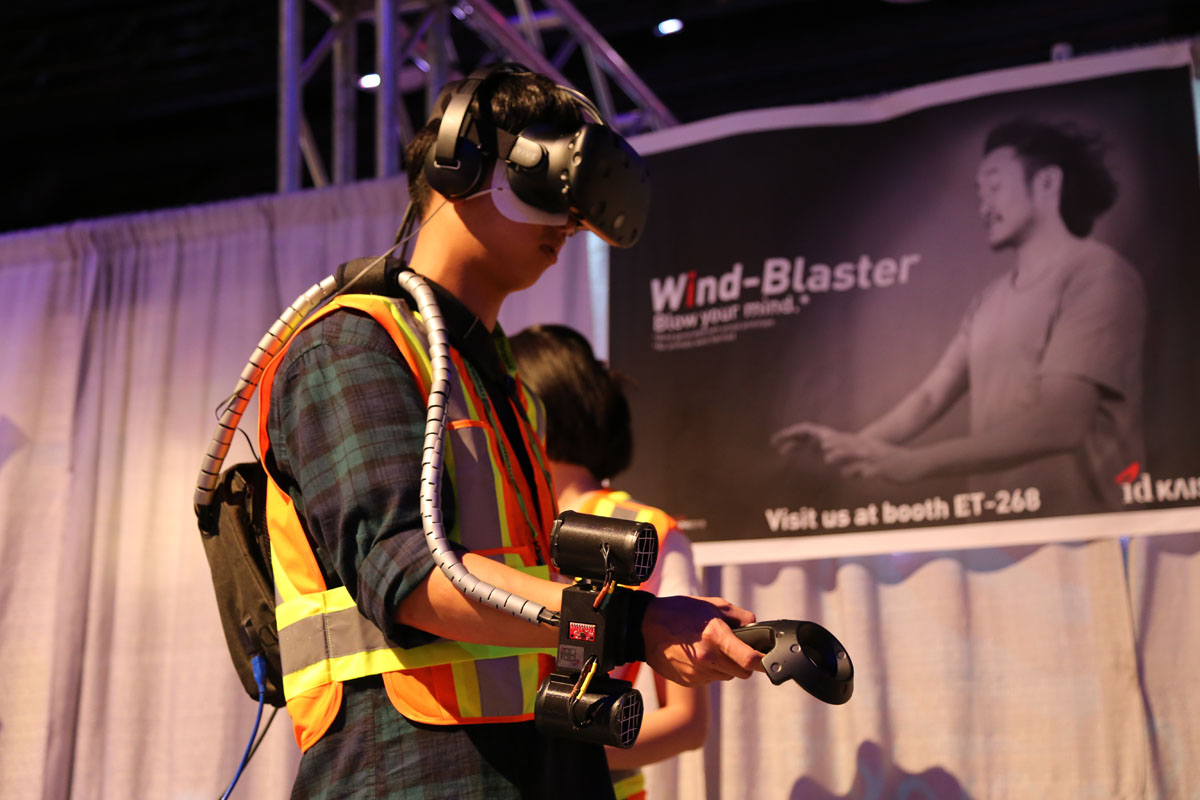How was it made? Wind-blaster
Issue: XXVI.1 January - February 2019Page: 14
Digital Citation
Authors:
Seungwoo Je, Hyelip Lee, Myung Kim, Minkyeong Lee, Yoonji Kim, Youngkyung Choi, Andrea Bianchi
Describe what you made. We built two wrist-mounted propellers to create a wearable force-feedback device for immersion in virtual reality (VR). The orientation of each propeller can be sensed with an inertial measurement unit (IMU) and controlled actively with the stepper motor component. To demonstrate the different forms of possible feedback—using variations in power, duration, and pattern—we later modified a VR application to develop a first-person-shooter game using the HTC Vive. Four noticeably different types of feedback were set, corresponding to four different types of weapons in the game.
 |
Prototype ver. 1, basic concept design. |
Briefly describe the process of how this was made. With some background in haptics, we started off with the slightly goofy idea of mounting a powerful propeller on the wrist, similar to Iron Man. From there, we made multiple iterations of the prototype and tested each version before making modifications and moving on to the next one. Starting with the design of the propellers' air ducts to maximize thrust, we aimed to maximize the force output of the device while keeping the form factor compact and wearable. Once the hardware was ready, we then proceeded to design an appropriate application to best showcase the hardware.
 |
Prototype ver. 2, air duct and directional control added. |
Did anything go wrong? During this project we were reminded once again that safety should come first. A custom 3D-printed propeller shattered while testing because it was not structurally sound due to its material properties.
We had clothes and straps get sucked into the propeller before we added safety nets to the air ducts.
Thankfully, no one got hurt. We also had clothes and straps get sucked into the propeller before we added safety nets to the air ducts. We burned a few components when we incorrectly rewired loose wires—that fried the desktop as well, so we had to get that repaired.
 |
Soldering a custom PCB. |
What is the one thing about making this that you would like to share with other makers? The key issue that struck us was the difficulty of balancing portability and the output force of the prototype for effective usage in VR as a wearable. The propellers are capable of exerting 10N. The prototype could be powered by directly wiring it to a high-current power supply, but that would limit its wearability. To increase wearability, we used large lithium-polymer batteries used in RC vehicles to power the device, causing its output force to be limited by the battery capacity.
 |
Prototype ver. 3, output force measurement on load cell. |
What expertise (skills and competences) did it require? This project required us to use most of our hardware-prototyping skills, including 3D modeling and design, PCB making and electronics, Arduino for processing and control, and, of course, plenty of soldering and wiring. We designed our custom PCB to be used in conjunction with the Arduino to sense the orientation of the device via the IMU, while controlling the RPM and direction of the propellers simultaneously. To maximize wearability, we modeled and 3D printed the prototype's outer casing and air ducts to be small but sturdy. The casing provides sufficient support for the sensors and motors inside and has the structural integrity to withstand the force output from the propellers.
 |
Testing the full system at a demo booth at SIGGRAPH 2018 E-TECH. |
 |
Weaving a tennis string net on the air ducts for safety. |
 |
Debugging the electronic components before final assembly. |
 |
Final assembly of the processing unit. |
 |
The wearable hardware system with processing and feedback units. |
Seungwoo Je, MAKinteract Lab, KAIST [email protected]
Hyelip Lee, MAKinteract Lab, KAIST
Myung Jin Kim, MAKinteract Lab, KAIST
Minkyeong Lee, MAKinteract Lab, KAIST
Yoonji Kim, MAKinteract Lab, KAIST
Youngkyung Choi, MAKinteract Lab, KAIST
Andrea Bianchi, MAKinteract Lab, KAIST
Copyright held by authors
The Digital Library is published by the Association for Computing Machinery. Copyright © 2019 ACM, Inc.


